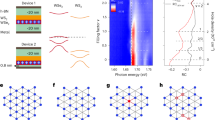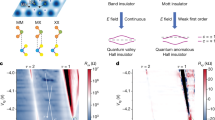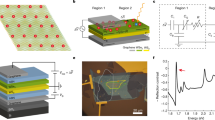Abstract
The electron’s kinetic energy plays a pivotal role in magnetism. While virtual electron hopping promotes antiferromagnetism in an insulator, real hopping processes usually favour ferromagnetism. However, in kinetically frustrated systems such as hole-doped triangular lattice Mott insulators, real hopping has instead been shown to favour antiferromagnetism. Kinetic frustration has also been predicted to induce a new quasiparticle, a bound state of the doped hole and a spin flip called a spin polaron, at intermediate magnetic fields, which could form an unusual metallic state. Here we report the direct observation of spin polarons in triangular lattice MoTe2/WSe2 moiré bilayers. A spin polaron phase emerges at a lattice filling factor just below 1 and is separated from the fully spin-polarized phase by a metamagnetic transition. We determine that the spin polaron is a spin-3/2 particle and that its binding energy is commensurate with the kinetic hopping energy. Our results will enable the exploration of spin polaron pseudogap metals, spin polaron pairing and other new phenomena in triangular lattice moiré materials.
This is a preview of subscription content, access via your institution
Access options
Access Nature and 54 other Nature Portfolio journals
Get Nature+, our best-value online-access subscription
$29.99 / 30 days
cancel any time
Subscribe to this journal
Receive 12 print issues and online access
$209.00 per year
only $17.42 per issue
Buy this article
- Purchase on Springer Link
- Instant access to full article PDF
Prices may be subject to local taxes which are calculated during checkout




Similar content being viewed by others
Data availability
Source data are provided with this paper. All other data are available from the corresponding authors upon reasonable request.
References
Gutzwiller, M. C. Effect of correlation on the ferromagnetism of transition metals. Phys. Rev. Lett. 10, 159–162 (1963).
Kanamori, J. Electron correlation and ferromagnetism of transition netals. Prog. Theor. Phys. 30, 275–289 (1963).
Hubbard, J. & Flowers, B. H. Electron correlations in narrow energy bands. Proc. R. Soc. Lond. Ser. A 276, 238–257 (1997).
Mott, N. F. Metal–insulator transition. Rev. Mod. Phys. 40, 677–683 (1968).
Anderson, P. W. Antiferromagnetism. Theory of superexchange interaction. Phys. Rev. 79, 350–356 (1950).
Nagaoka, Y. Ferromagnetism in a narrow, almost half-filled s band. Phys. Rev. 147, 392–405 (1966).
Salamon, M. B. & Jaime, M. The physics of manganites: structure and transport. Rev. Mod. Phys. 73, 583–628 (2001).
Bohrdt, A., Homeier, L., Reinmoser, C., Demler, E. & Grusdt, F. Exploration of doped quantum magnets with ultracold atoms. Ann. Phys. 435, 168651 (2021).
Kim, K.-S., Murthy, C., Pandey, A. & Kivelson, S. A. Interstitial-induced ferromagnetism in a two-dimensional Wigner crystal. Phys. Rev. Lett. 129, 227202 (2022).
Seifert, U. F. P. & Balents, L. Spin polarons and ferromagnetism in doped dilute moiré-Mott insulators. Phys. Rev. Lett. 132, 046501 (2024).
Haerter, J. O. & Shastry, B. S. Kinetic antiferromagnetism in the triangular lattice. Phys. Rev. Lett. 95, 087202 (2005).
Sposetti, C. N., Bravo, B., Trumper, A. E., Gazza, C. J. & Manuel, L. O. Classical antiferromagnetism in kinetically frustrated electronic models. Phys. Rev. Lett. 112, 187204 (2014).
Zhang, S.-S., Zhu, W. & Batista, C. D. Pairing from strong repulsion in triangular lattice Hubbard model. Phys. Rev. B 97, 140507 (2018).
Tang, Y. et al. Simulation of Hubbard model physics in WSe2/WS2 moiré superlattices. Nature 579, 353–358 (2020).
Lee, K., Sharma, P., Vafek, O. & Changlani, H. J. Triangular lattice Hubbard model physics at intermediate temperatures. Phys. Rev. B 107, 235105 (2023).
Davydova, M., Zhang, Y. & Fu, L. Itinerant spin polaron and metallic ferromagnetism in semiconductor moiré superlattices. Phys. Rev. B 107, 224420 (2023).
Morera, I. et al. High-temperature kinetic magnetism in triangular lattices. Phys. Rev. Res. 5, L022048 (2023).
Xu, M. et al. Frustration- and doping-induced magnetism in a Fermi–Hubbard simulator. Nature 620, 971–976 (2023).
Carlström, J. In situ controllable magnetic phases in doped twisted bilayer transition metal dichalcogenides. Phys. Rev. Res. 4, 043126 (2022).
Tang, Y. et al. Evidence of frustrated magnetic interactions in a Wigner–Mott insulator. Nat. Nanotechnol. 18, 233–237 (2023).
Zhang, Y. & Fu, L. Pseudogap metal and magnetization plateau from doping moiré Mott insulator. SciPost Phys. Core 6, 038 (2023).
Ciorciaro, L. et al. Kinetic magnetism in triangular moiré materials. Nature 623, 509–513 (2023).
Wu, F., Lovorn, T., Tutuc, E. & MacDonald, A. H. Hubbard model physics in transition metal dichalcogenide moiré bands. Phys. Rev. Lett. 121, 026402 (2018).
Regan, E. C. et al. Mott and generalized Wigner crystal states in WSe2/WS2 moiré superlattices. Nature 579, 359–363 (2020).
Shimazaki, Y. et al. Strongly correlated electrons and hybrid excitons in a moiré heterostructure. Nature 580, 472–477 (2020).
Wang, L. et al. Correlated electronic phases in twisted bilayer transition metal dichalcogenides. Nat. Mater. 19, 861–866 (2020).
Andrei, E. Y. et al. The marvels of moiré materials. Nat. Rev. Mater. 6, 201–206 (2021).
Kennes, D. M. et al. Moiré heterostructures as a condensed-matter quantum simulator. Nat. Phys. 17, 155–163 (2021).
Mak, K. F. & Shan, J. Semiconductor moiré materials. Nat. Nanotechnol. 17, 686–695 (2022).
Foutty, B. A. et al. Tunable spin and valley excitations of correlated insulators in Γ-valley moiré bands. Nat. Mater. 22, 731–736 (2023).
Li, T. et al. Quantum anomalous Hall effect from intertwined moiré bands. Nature 600, 641–646 (2021).
Zhao, W. et al. Gate-tunable heavy fermions in a moiré Kondo lattice. Nature 616, 61–65 (2023).
Zheng, W., Singh, R. R. P., McKenzie, R. H. & Coldea, R. Temperature dependence of the magnetic susceptibility for triangular-lattice antiferromagnets with spatially anisotropic exchange constants. Phys. Rev. B 71, 134422 (2005).
Xu, Y. et al. Correlated insulating states at fractional fillings of moiré superlattices. Nature 587, 214–218 (2020).
Huang, X. et al. Correlated insulating states at fractional fillings of the WS2/WSe2 moiré lattice. Nat. Phys. 17, 715–719 (2021).
Li, T. et al. Charge-order-enhanced capacitance in semiconductor moiré superlattices. Nat. Nanotechnol. 16, 1068–1072 (2021).
Li, G., Antipov, A. E., Rubtsov, A. N., Kirchner, S. & Hanke, W. Competing phases of the Hubbard model on a triangular lattice: insights from the entropy. Phys. Rev. B 89, 161118 (2014).
Samajdar, R. & Bhatt, R. N. Nagaoka ferromagnetism in doped Hubbard models in optical lattices. Preprint at https://arxiv.org/abs/2305.05683 (2023).
Zapf, V., Jaime, M. & Batista, C. D. Bose–Einstein condensation in quantum magnets. Rev. Mod. Phys. 86, 563–614 (2014).
Wang, Z., Shan, J. & Mak, K. F. Valley- and spin-polarized Landau levels in monolayer WSe2. Nat. Nanotechnol. 12, 144–149 (2017).
Zhang, Y., Devakul, T. & Fu, L. Spin-textured Chern bands in AB-stacked transition metal dichalcogenide bilayers. Proc. Natl Acad. Sci. USA 118, e2112673118 (2021).
Schrieffer, J. R., Wen, X.-G. & Zhang, S.-C. Spin-bag mechanism of high-temperature superconductivity. Phys. Rev. Lett. 60, 944–947 (1988).
Acknowledgements
We thank L. Fu, Y. Zhang, M. Davydova and J. Dong for fruitful discussions. The work was supported by the Air Force Office of Scientific Research under award number FA9550-19-1-0390 (magneto-optical studies), the US Department of Energy, Office of Science, Basic Energy Sciences, under award number DE-SC0019481 (device fabrication) and the National Science Foundation under DMR-1807810 (analysis). The work was also funded in part by the Gordon and Betty Moore Foundation (https://doi.org/10.37807/GBMF11563). The growth of the h-BN crystals was supported by the Elemental Strategy Initiative of MEXT, Japan and CREST (JPMJCR15F3), JST. We used the Cornell NanoScale Facility, an NNCI member supported by NSF grant NNCI-2025233 for device fabrication. We also acknowledge support from the Kavli Postdoctoral Fellowship (W.Z.) and the Swiss National Science Foundation (P.K.).
Author information
Authors and Affiliations
Contributions
Z.T. and W.Z. performed the optical and electrical measurements and the analysis with the help of P.K. and B.S.; B.S. and T.L. fabricated the devices. K.W. and T.T. grew the bulk h-BN crystals. Z.T., K.F.M. and J.S. designed the scientific objectives and oversaw the project. All authors discussed the results and commented on the paper.
Corresponding authors
Ethics declarations
Competing interests
The authors declare no competing interests.
Peer review
Peer review information
Nature Physics thanks Farsane Tabataba-Vakili, and the other, anonymous, reviewer(s) for their contribution to the peer review of this work.
Additional information
Publisher’s note Springer Nature remains neutral with regard to jurisdictional claims in published maps and institutional affiliations.
Extended data
Extended Data Fig. 1 Schematic superlattice structure and moiré bands in AB-stacked MoTe2/WSe2.
a, Moiré pattern (left) formed in AB-stack MoTe2/WSe2. MM, MX and XX (M = Mo, W; X = Se, Te) are the high-symmetry stacking sites (right). The Wannier orbitals of the topmost moiré valence band occupy the MM sites, forming a triangular lattice. The arrow labels the electric field direction in our experiment. b, Schematic illustration of the electric field effect on the band alignment at \(\nu =1\). Grey dashed line indicates the Fermi level at \(\nu =1.\) Left: The Mo-moiré band is split into the lower and upper Hubbard bands by the on-site Coulomb \(U\). The W-moiré band lies well below the Mott gap, resulting in a single-band Hubbard model. Right: With increasing electric field, the W-moiré band is pushed up but remains well separated from the Mo-Hubbard band in our experiment.
Extended Data Fig. 2 Additional results at E = 0.3 V/nm.
a, Magnetic-field dependent MCD at representative filling factors at 1.6 K for both field polarities. The intermediate MCD plateau is observed for \(0.83\lesssim \nu \lesssim 0.93.\) b, Filling factor dependent magnetization ratio between the intermediate plateau and full saturation. The dashed line describes \(\frac{1-3x}{1-x}\). c, Filling factor dependent saturation field \({B}_{s}\) and metamagnetic transition field \({B}_{m}\) extracted from experiment (symbols). The lines are guide to the eye. The shaded area represents the region for the spin polaron phase.
Extended Data Fig. 3 Filling factor calibration.
a,b, Filling factor dependence of the two-terminal longitudinal resistance (a) and the MCD spectrum (at 0.6 T, b) simultaneously measured at 1.6 K. The resistance peak identifies the \(\nu =1\) Mott insulating state (dashed line). The filling factor and moiré density calibration is further confirmed by quantum oscillation measurements and the known Landau level degeneracy in the WSe2 layer. The small shift between the resistance and the MCD peak is reproducible at different electric fields and in different devices.
Extended Data Fig. 4 Magnetic field dependent MCD spectrum at selected filling factors.
The electric field is fixed at 0.5 V/nm; the temperature is 1.6 K. Three intralayer moiré exciton resonances from MoTe2 can be identified. The dashed lines show the spectral range for MCD integration. The arrows indicate the metamagnetic transition field \({B}_{m}\), where a kink in the MCD spectrum is observed.
Extended Data Fig. 5 Magnetic field dependent MCD at varying fillings.
a,b, Magnetic field dependence of the MCD (a) and the MCD derivative (b) at representative filling factors and at 1.6 K in the positive field direction. The electric field is fixed at 0.5 V/nm. The curves are vertically displaced for clarity. An intermediate MCD plateau at magnetic field between 2 - 4 T is observed for filling factor between 0.8 – 1. The MCD plateau manifests as a local minimum in MCD derivative.
Extended Data Fig. 6 Filling factor dependent susceptibility and Curie-Weiss temperature θ.
a,b, Filling factor dependence of the magnetic susceptibility \(\chi\) at 1.6 K (a) and the Curie-Weiss temperature \(\theta\) (b). The magnetic susceptibility is obtained by fitting the MCD slope at zero magnetic field. The analysis is described in the main text, and the result near \(\nu =1\) is included in Fig. 3d. A suppression of the AF interaction is observed, as evidenced by a peak in \(\chi\) and a dip in \(\theta\) for the Wigner-Mott insulator at \(\nu\) = 2/3 (arrows). Inset in a: Filling factor dependence of \(\chi\) at 1.6 K over a broader filling factor range. No sign of FM interaction is observed above \(\nu =1.2\).
Extended Data Fig. 7 Analysis of the magnetization ratio.
a,b, Examples of determining the magnetization ratio at \(\nu =0.91\) (a) and \(\nu =0.89\) (b). The magnetization ratio is obtained by the MCD ratio between the spin polaron magnetization \({m}_{1}\) and the saturation magnetization \({m}_{2}\), that is \(\frac{{m}_{1}}{{m}_{2}}\) (horizontal dashed lines). The spin polaron magnetization \({m}_{1}\), which corresponds to the intermediate plateau in MCD, is determined by the local minimum of the MCD derivative (vertical dashed lines).
Extended Data Fig. 8 Reproducibility in another device.
a, MCD spectrum at B = 0.6 T as a function of filling factor ν. The out-of-plane electric field is fixed at 0.5 V/nm. Three intralayer moiré exciton resonances from MoTe2 can be identified. The dashed lines show the spectral range for MCD integration. b,c, Magnetic-field dependence of the MCD (b) and MCD derivative (c) at representative filling factors. An intermediate MCD plateau at magnetic field between 2 - 4 T is observed for filling factor between 0.8 – 1. Two examples are shown for \(\nu\) = 0.92 and 0.89. The intermediate MCD plateau manifests a local minimum in the MCD derivative. The dashed lines denote the two ends of the plateau, \({B}_{s}\) and \({B}_{m}\). For filling above 1 and below 0.8, only one of the fields can be identified. d, Filling dependent ratio of the intermediate magnetization plateau to the saturation magnetization (symbols). It follows \(\frac{1-3x}{1-x}\) (dashed line).
Extended Data Fig. 9 Magnetic field dependent MCD at varying probe light intensities.
The MCD profile does not change with the probe light intensity over one order of magnitude, showing that the probe light does not perturb the spin polaron phase.
Extended Data Fig. 10 Additional MCD analysis.
a, MCD spectrum at B = 0.6 T as a function of filling factor ν. The out-of-plane electric field is fixed at 0.5 V/nm. The dashed lines show the spectral range for MCD integration, which covers the strongest moiré exciton resonance. b,c, Magnetic-field dependence of the MCD (b) and MCD derivative (c) at representative filling factors. The results are qualitatively the same as those from full spectral integration in the main text. In particular, an intermediate MCD plateau at magnetic field between 2 - 4 T is observed for filling factor between 0.8 – 1. d, Filling dependent ratio of the intermediate magnetization plateau to the saturation magnetization (symbols). It follows \(\frac{1-3x}{1-x}\) (dashed line).
Source data
Source Data Fig. 1
Statistical source data for Fig. 1.
Source Data Fig. 2
Statistical source data for Fig. 2.
Source Data Fig. 3
Statistical source data for Fig. 3.
Source Data Fig. 4
Statistical source data for Fig. 4.
Rights and permissions
Springer Nature or its licensor (e.g. a society or other partner) holds exclusive rights to this article under a publishing agreement with the author(s) or other rightsholder(s); author self-archiving of the accepted manuscript version of this article is solely governed by the terms of such publishing agreement and applicable law.
About this article
Cite this article
Tao, Z., Zhao, W., Shen, B. et al. Observation of spin polarons in a frustrated moiré Hubbard system. Nat. Phys. (2024). https://doi.org/10.1038/s41567-024-02434-y
Received:
Accepted:
Published:
DOI: https://doi.org/10.1038/s41567-024-02434-y



